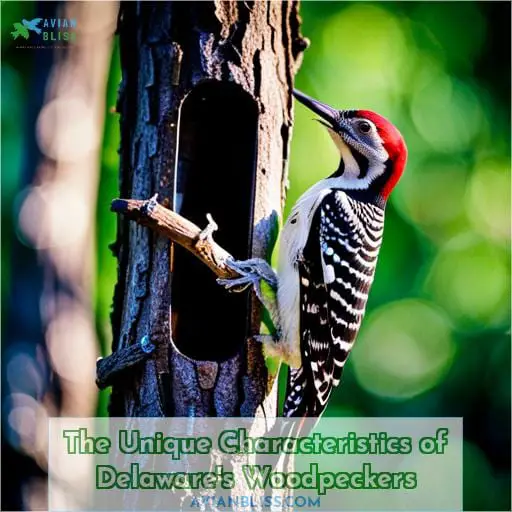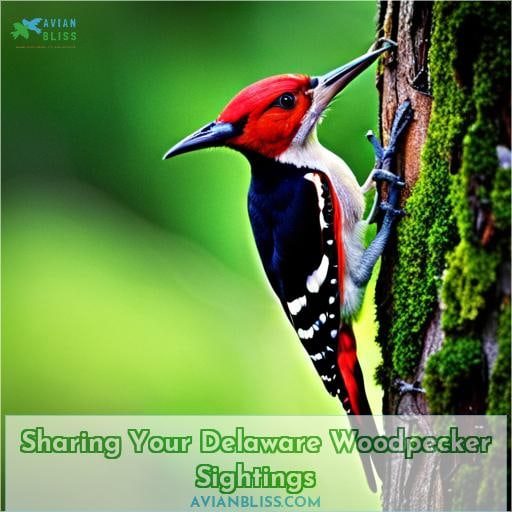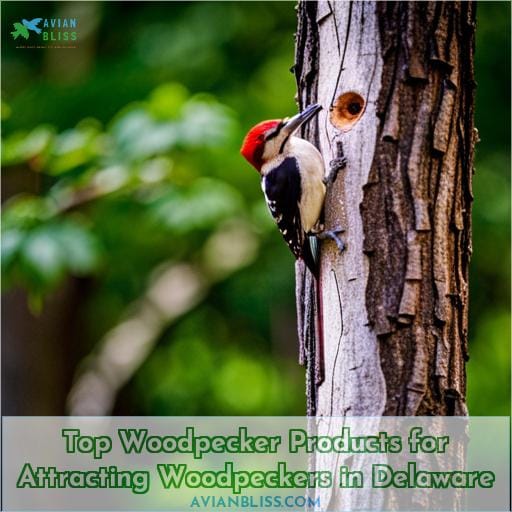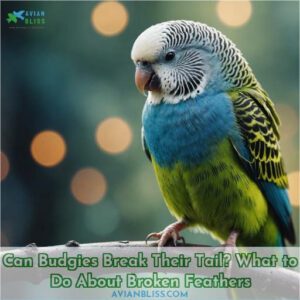This site is supported by our readers. We may earn a commission, at no cost to you, if you purchase through links.
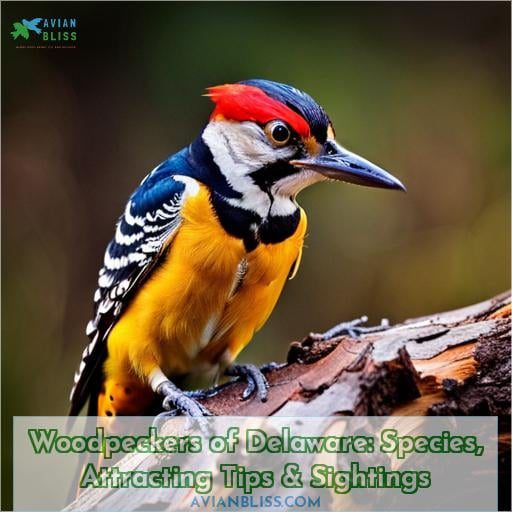 Are you a bird enthusiast in Delaware looking for an adventure? Look no further! There are seven native woodpecker species to discover within the state, each with its own unique characteristics and behaviors.
Are you a bird enthusiast in Delaware looking for an adventure? Look no further! There are seven native woodpecker species to discover within the state, each with its own unique characteristics and behaviors.
From Downy Woodpeckers to Pileated Woodpeckers, we’ll cover all of them and provide tips on how you can attract these feathered friends to your backyard.
We’ll also explore some of the products available that will help bring out more woodpeckers of Delaware into your yard so that you can enjoy their beauty up close!
So let’s get started on our journey through the world of woodpecker watching in The First State!
Table Of Contents
Key Takeaways
- Delaware is home to seven native woodpecker species.
- Common woodpecker species in Delaware include Downy, Hairy, Northern Flicker, Pileated, and Red-bellied Woodpeckers.
- To attract woodpeckers, use suet, black sunflower seeds, and native fruit-bearing plants.
- Report woodpecker sightings on platforms like eBird, iNaturalist, or local birding groups.
Top 5 Woodpeckers Found in Delaware
Delaware hosts a diversity of woodpecker species that bird enthusiasts strive to observe. As a seasoned Delaware birder, you likely hope to spot the Downy Woodpecker’s distinctive red spot, the Hairy Woodpecker’s larger bill, the Northern Flicker’s ground-feeding behavior, the awe-inspiring Pileated Woodpecker, and the Red-bellied Woodpecker’s recognizable crimson plumage when woodpecker-watching across the state.
Downy Woodpecker
If you’re ogling at that tiny woodpecker with a whinnying call at your backyard feeder, most likely it’s the shrimpy Downy looking to peck some seeds in Delaware! Feasting on insects, spiders, and fruits, this little dude visits feeders for suet and sunflowers.
Identifiable by its drumming, small size, and distinctive markings, the Downy thrives in mixed and deciduous forests statewide.
Hairy Woodpecker
You’ll recognize the large Hairy Woodpecker by its shrill rattling call as it works the trunks and branches of oaks and hickories. Larger than the Downy, the Hairy sports a chisel-like bill adept at excavating into wood.
With black and white barred plumage and a flashy red patch on males, watch for these woodpeckers drumming on trees and feeding on insects, nuts, sap, and fruit.
Northern Flicker
You’d notice the black bib and red on its head as the Northern Flicker forages along the ground, picking insects from the grass in your backyard.
- Prefers open woodlands and forest edges.
- Feeds on ants and beetles on the ground.
- Migrates south in winter from Delaware.
- Uses its long tongue to capture ants deep in tunnels.
- Makes a loud, recognizable klee-yer call.
Pileated Woodpecker
Have a look out for the large black woodpecker with a red crest when visiting mature forests in Delaware. Pileated woodpeckers hammer loudly on dead trees that other birds avoid, creating cavities for nests.
These striking woodpeckers prefer to feed on carpenter ants and beetle larvae found in standing dead trees and fallen logs. Conserve habitat by retaining dead trees and planting native fruit and nut trees to help support future pileated woodpecker populations.
Red-bellied Woodpecker
Catch sight of the red-bellied woodpecker’s black and white barred back and red plumage as it dominates your backyard feeders.
- Feeds on insects, fruits, seeds, and nuts.
- Has a long barbed tongue adapted for extracting insects.
- Stores seeds and nuts in tree crevices.
- Excavates nest cavities in dead trees or limbs.
- Recognizable churr vocalizations.
Attracting Woodpeckers to Your Backyard in Delaware
Enhance your backyard habitat to attract a variety of woodpecker species. Offer quality food sources like suet and black sunflower seeds, keep any snags or dead trees for foraging and nesting, use nest boxes suited to the species in your area, and plant native fruit-bearing trees and shrubs to provide natural sources of food.
Don’t forget to install a solar-powered fountain or birdbath to provide a constant water source as woodpeckers need to drink regularly.
Offering Suet and Black Sunflower Seeds
Fill your feeders with nutritious suet cakes and black sunflower seeds daily to provide woodpeckers with the high-fat foods they crave.
| Suet Benefits | Seed Preferences |
|---|---|
| High-fat content | Rich in oils |
| Energy-dense | Small enough for woodpeckers to pick up |
Woodpeckers appreciate having suet and sunflower seeds available year-round. Offering them consistently will attract these colorful birds to your yard.
Keeping Dead Trees
Leave standing dead trees for nesting and food. They provide essential habitat for woodpeckers and other wildlife. The cavities offer nesting sites, shelter, and a place to store food. Preserving dead trees enhances biodiversity and supports hairy woodpeckers, yellow-bellied sapsuckers, and pileated woodpeckers.
Using Nest Boxes
Hang nest boxes specifically designed for woodpeckers to provide suitable cavities for nesting and roosting. Select the right box for your species, such as the BWD53 for Downies or NCH for Flickers. Face the entrance hole south or east in an open area near tree trunks. Clean out old nesting material annually.
Proper placement and maintenance will give woodpeckers a safe home to raise young, benefiting your backyard biodiversity.
Planting Native Fruit-Bearing Plants
Grow glistening wild grapes to entice eager woodpeckers. Red mulberry, chokecherry, serviceberry, and elderberry provide nourishing fruits. Planting native trees that bear fruits eaten by woodpeckers is an excellent way to attract these spectacular birds.
They’ll flock to our yards when we make the effort to cultivate plants benefiting avian wildlife.
Providing a Water Source With a Solar Fountain
Let a solar fountain oxygenate the water and delight the woodpeckers.
- Provides hydration without electricity
- The solar panel powers the pump to circulate water
- Delivers moving water preferred by birds
The Unique Characteristics of Delaware’s Woodpeckers
Among Delaware’s woodpeckers, the Red-headed Woodpecker stands out with its striking crimson head contrasting a black back and white belly. This species also exhibits the unique behavior of storing acorns and nuts for later feeding.
The Red-headed Woodpecker has a distinctive black and white body with a brilliant red head and neck in the adult birds. It is an adept flycatcher, sometimes sallying out from its perch to catch insects in mid-air.
This woodpecker prefers open habitats like meadows, pastures, golf courses, orchards, and savannas with mature trees for nesting.
The Red-headed Woodpecker lives up to its name with the male’s unmistakable cherry red head and neck. Beyond its flashy plumage, this species displays interesting feeding behaviors like storing nuts and acorns in tree crevices to eat later.
Attuned observers can spot these woodpeckers by watching and listening for them in open, tree-dotted landscapes across Delaware. With a little patience, you may be rewarded with a sighting of this visually striking woodpecker.
Sharing Your Delaware Woodpecker Sightings
Birdwatching in Delaware offers ample opportunities to observe the state’s diverse woodpecker species. By reporting your sightings through eBird, iNaturalist, or local birding groups, you can contribute valuable data for ornithological research and conservation efforts while also connecting with the birding community.
How to Share Your Sightings
Sneak peeks of woodpeckers from your backyard to the Delaware Nature Society’s logging app so we can all appreciate their majesty. Help fellow birders by reporting sightings of these elusive woodpeckers. Detailed logs noting behavior and characteristics aid research and conservation efforts.
Share photos, recordings, location, date, and time. Your contribution builds collective knowledge, allowing us to better understand population trends. Let’s foster community and enrich our appreciation of woodpeckers by pooling observations.
Importance of Reporting Sightings
Sharing your observations of Delaware’s elusive woodpeckers reveals spots where these keystone cavity nesters thrive, data that guides efforts to protect vital habitat. Your sightings fill gaps in range maps, track population trends, and inform conservation decisions.
By contributing to citizen science databases, you aid researchers, engage fellow birders, and gain insights into woodpecker ecology in your region.
Contributing to Citizen Science
You’re helping science by reporting sightings.
- Capturing details like date, location, and behavior
- Submitting photos for expert review
- Noting habitat and identifying features
- Alerting researchers to trends and changes
Citizen scientists make valuable contributions. Your sightings expand knowledge of woodpecker populations, behaviors, and responses to environmental changes. They inform habitat conservation and species management. With your sightings, you aid avian research and conservation right here in Delaware.
Engaging With the Birding Community
Report your Delaware woodpecker sightings on eBird to engage with the birding community. Join regional birding events and share photos on outings to contribute records. Connect with groups working on conservation efforts at local hotspots.
Participate in winter bird counts and year-round challenges that aid science and stewardship. Your field observations inform habitat management, guide research, and build networks.
Top Woodpecker Products for Attracting Woodpeckers in Delaware
As a seasoned Delaware birder, you know that offering the right foods and water features is key to attracting beautiful woodpeckers. The Pileated Suet Feeder’s sturdy recycled plastic design with a handy tail prop is ideal for larger woodpeckers, while the AISITIN Solar Fountain Pump can provide a reliable eco-friendly water source to entice birds like Yellow-bellied Sapsuckers.
Pileated Suet Feeder Double Cake Recycled Taupe Brown
This sturdy recycled suet feeder attracts all kinds of woodpeckers to your yard. Its large, stable design is perfect for feeding bigger birds like Pileated Woodpeckers, Northern Flickers, and Red-bellied Woodpeckers.
Here are 4 key benefits of this feeder:
- Holds up to 2 suet cakes for ample feeding capacity.
- Features durable, weather-resistant recycled plastic construction.
- Includes a tail prop specifically designed for larger woodpecker species.
- Made in the USA from recycled materials.
Offering suet-rich foods in this specialized feeder is an excellent way to supplement woodpecker diets and attract them to your backyard. Observing these remarkable birds up close as they feed brings great joy to passionate birders across Delaware.
With thoughtful bird feeding practices, we can support local woodpecker populations and connect with nature right outside our homes.
AISITIN Solar Fountain Pump With Battery
Set up an eco-friendly solar fountain with the AISITIN pump to provide water movement and attract hummingbirds. The solar panel converts sunlight to power the 1500 mAh battery, so no wiring is needed.
Position the fountain near vegetation to provide added cover for visiting birds. Make sure the solar panel receives ample sunlight. Regularly clean the fountain to prevent clogs from feathers and debris. Birds need fresh water, making this solar kit an ideal birdbath fountain without ongoing electricity costs.
Invite orioles, tanagers, and warblers to your yard habitat by adding this solar fountain. Hummingbirds especially favor running water for drinking and bathing. The rechargeable battery allows for nighttime operation to keep the water flowing.
Experiment with different sprayer positions to limit splashing while aerating the water. Incorporating this fountain pump into your yard is easy with its simple setup and solar power.
Conclusion
From the familiar Downy Woodpecker to the striking Red-headed Woodpecker, Delaware boasts a wide variety of woodpecker species. With the tips and products outlined in this article, you can bring these beautiful birds into your backyard and enjoy the colorful and unique calls of each species.
To help protect and conserve the woodpeckers of Delaware, it’s important to share your sightings with the birding community and contribute to citizen science. So be sure to keep your eyes peeled and your ears open for these feathered friends – your observations can make a difference.
As the saying goes, it takes a village – or, in this case, a flock – to preserve and protect Delaware’s woodpeckers.



